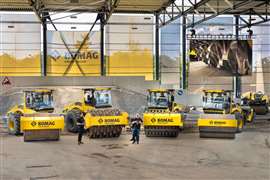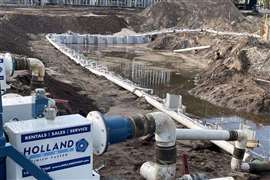Rental leaders strive toward greater sustainability
07 February 2024
The global rental and construction sectors are witnessing a significant shift, recognizing the pivotal role both industries have in promoting environmentally conscious practices in equipment, people and processes. Lewis Tyler investigates.
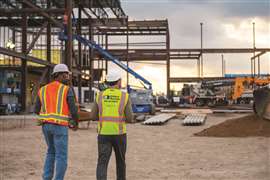 United Rentals’ white paper outlines four steps to reduce emissions, as well as the tools and equipment to make sustainability strategies a reality. (Photo: United Rentals)
United Rentals’ white paper outlines four steps to reduce emissions, as well as the tools and equipment to make sustainability strategies a reality. (Photo: United Rentals)
From energy-efficient machinery to advanced materials and innovative construction methods, the rental and construction sectors are embracing a green and inclusive revolution across their operations.
In the midst of this shift, the rental industry has integrated both internal and external sustainable processes and technologies.
Whether through zero- or low-emission equipment, technology to monitor sustainability goals or programs to diversify the workforce, companies are continuing to develop strategies in large numbers.
Shift in priorities
Take for example Nordic-based rental company Renta Group, which appointed its first ever head of sustainability last year. Rebecca Långström took the role as quality and environmental manager in Sweden for the Group. Her remit, according to Långström, is to ensure the sustainability goals of Renta’s locations are aligned with targets on a Group level.
“Right now, I’m trying to improve the process that we started last year,” Långström says. “We had a system that was from a consultancy for sustainability reporting for the countries to enter their data. The feedback we got from that and my personal view was that it wasn’t a very good system.”
Because of this, Renta is implementing a new sustainability platform, one in which all the sustainability data will be kept, while also allowing the company to carry out supply screenings and ESG-related tasks.
Meanwhile, it is aiming to keep abreast of Scope 3 emissions regulations, which she says are the company’s “biggest challenge,” in particular the supply chain, transportation and manufacture
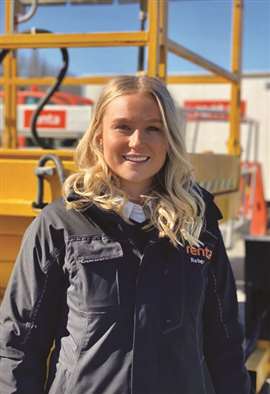 Rebecca Långström took the role as quality and environmental manager in Sweden for the Renta Group and is charged with ensuring the company’s sustainability goals are properly aligned and achieved.
Rebecca Långström took the role as quality and environmental manager in Sweden for the Renta Group and is charged with ensuring the company’s sustainability goals are properly aligned and achieved.
and use of products.
One of the first tasks she set for herself was to reach out to suppliers to see if they are covered by the Corporate Sustainability Reporting Directive (CSRD) and if they can report on C02 emissions on transportation.
“On Scope 3, we are very transparent on the challenges. We have to collect the data and we are very much depending on our suppliers for this, and our customers will be depending on us to deliver the data,” she says.
Elsewhere, Ashtead is aiming to reduce Scope 1 and 2 carbon intensity per $m of revenue by 35% by 2030, and to hit an interim target of 15% by 2024.
The company plans to reduce its greenhouse gas emissions by 14% over last year, according to its 2023 Sustainability Report which outlines the company’s primary objectives for lowering its carbon footprint.
“We are focusing our effort on company-owned vehicles, which account for around 80% of our greenhouse gas emissions from operations,” the report says.
“We continue to work as a partner in innovation with our equipment suppliers to develop and bring to market more efficient, electric and lower-impact machines. We are also increasingly delivering integrated and environmentally responsible rental solutions for our customers.”
In FY 2023, Ashtead said it will take delivery of a range of electric light and heavy commercial vehicles (EVs) to test in operations. To enhance carbon reporting, the company is measuring Scope 3 carbon emissions from its supply chain and customers’ use of rented equipment.
“We believe that protecting the environment and investing in the greenest rental fleet possible will deliver competitive advantage for our business,” according to the report.
Approximately 20% of Ashtead’s rental fleet is comprised of battery, electric, hybrid and solar-powered assets. These include assets such as electric scissor lifts and tower lights.
A total of 10% of Ashtead’s UK fleet is now powered by biodiesel.
Science-based targets
In the UK, Speedy Hire launched its ‘Decade to Deliver’ Net Zero roadmap in 2023. The company says the strategy provides clear, science-based targets with tangible steps to reach Net Zero by 2040, 10 years ahead of the Government deadline. It aims to reduce Scope 1 & 2 emissions by 50% and Scope 3 emissions by 42% by 2030.
To achieve this, it will replace 100% of petrol and diesel cars within its fleet with electric vehicles (EVs), transition 66% of diesel vans and 15% of UK-based HGVs to electric and transition a further 25% of UK-based vans and HGVs to low carbon alternatives like HVO.
Other targets include a 100% renewable electricity operation by FY2027 in the UK and Ireland, reduction of refrigerant leakage by 14% and natural gas emissions by 30% and to work with its top 30 suppliers to help set their own science-based targets.
Amelia Woodley, ESG director, Speedy Hire, says, “Following extensive planning and outlining the key objectives of the ‘Decade to Deliver’ strategy, we are now in the process of embedding the roadmap across the business.
 Renta is working on an internal sustainability system to carry out supply screenings and ESG-related tasks. (Photo: Renta Group)
Renta is working on an internal sustainability system to carry out supply screenings and ESG-related tasks. (Photo: Renta Group)
“To effectively do so, we have taken those objectives and worked with each unit of the business to develop bespoke plans that address their specific needs to reach these goals. We also evaluated which of the targets are most relevant to the different divisions. For example, working with our Fleet division to evaluate the impact that our goal of replacing diesel and petrol cars with EVs has on the Fleet unit and how it will be managed by the team.”
Speedy is also implementing company-wide training programs to ensure that staff are trained in sustainability, while also providing 30 members of staff with a “Sustainable Business Partner Program” in partnership with the Institute of Environmental Management and Assessment (IEMA).
Upon completing the program, their roles will be transformed into “green roles to future proof the workforce and ensure delivery of our key targets,” Woodley says.
Social changes
Diversity and inclusion (D&I) is also a key factor for sustainability, which can also include corporate support of local communities through effective recruitment of personnel, as well as emergency support when needed, such is the case for Ashtead.
“We continue to open new stores, bringing opportunities through recruitment, economic activity and a new avenue for local support into these communities,” according to their report. “Our emergency response team continued to grow and we were able to support, often as a first responder, in times of crisis. We maintained some of our long-term charity partnerships, investing in
 Amelia Woodley, ESG director at Speedy Hire, says the company is in the process of executing its ‘Decade to Deliver’ strategy across the business.
Amelia Woodley, ESG director at Speedy Hire, says the company is in the process of executing its ‘Decade to Deliver’ strategy across the business.
key initiatives and supporting through our employee volunteering days.”
The company has also established an employee wellness approach called Engage for Life. Part of an overall safety program, it includes ‘PowerUp’ to get employees ‘ready to go’ every morning.
It also continues to invest in training and development, including online courses. A total of 1.2 million training hours were delivered in 2023.
Meanwhile, the company’s pursuit of a more diverse and inclusive workforce took a step forward with the establishment of its Diversity, Equity and Inclusion Task Force and a women’s employee resource group across North America.
“First and foremost, safety is our leading priority,” the report states. “We continue to look for ways in which we can enhance further our safety policies and procedures and have improvement plans in a number of areas, including enhancing how we monitor and measure performance, and how we can use technology to enhance safety across the business.”
Back across the Atlantic, Långström says she has noted “challenges to attract skilled workforce.”
“We have big challenges to attract a skilled workforce and there’s a salary war between the companies on where the personnel should go.
“From the things I know in the different countries that we are operating in, it’s the same there as well. It’s hard to attract and to retain personnel as well and you have to constantly develop and train and offer things. It’s not just money and we can see that when we are doing a service from a younger crowd that the sustainability is a very important part in choosing your employer.
“That’s a main reason why we should focus on these areas, because we want to attract good workers and it’s becoming more and more important to have a workplace that you can actually be proud of.”
Although the company doesn’t plan to open up its own initiatives to tackle these issues, one key focus will be the participation in forums to attract female and nonbinary people, she says. For example, it has started a female network for people working in the company, and this is to be extended across other countries.
Greener choices
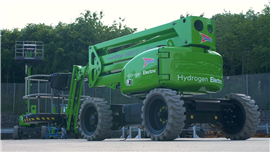 Speedy Hire and Niftylift signed a deal in 2023 to manufacture the world’s first hydrogen-electric powered access platform. (Photo: Speedy Hire)
Speedy Hire and Niftylift signed a deal in 2023 to manufacture the world’s first hydrogen-electric powered access platform. (Photo: Speedy Hire)
While the focus among equipment rental companies has inevitably shifted towards improving internal sustainability, much is still being done to lower emissions of the rental customer.
For example, in January United Rentals published its Roadmap to Low-Emission and Zero-Emission Jobsites white paper, which outlines four steps to reduce emissions and the tools and equipment to make sustainability strategies a reality on the jobsite through the use of digital tools.
United says the tools, which it released just weeks after the launch of its carbon emissions estimator, can guide fleet sustainability decisions and greener equipment options that help construction and industrial companies reach lower-emission targets without reducing profit.
The first step the company has outlined urges companies to use data to guide decisions around fleet sustainability efforts to identify changes that bring the biggest return on investment.
United says this is a more realistic improvement than replacing an entire fleet with lower-emission equipment.
Meanwhile, it said the utilisation of alternative power generation solutions such as renewable diesel, hydrogen and solar energy can “provide the power needed for productivity and safety” while reducing emissions. It also highlighted battery energy storage systems as a key tool to reduce the use of emission-generating portable power equipment, adding that some units can replace diesel generators and be added to existing systems to create a hybrid power solution.
Finally, the company said the addition of electric or hybrid equipment to a fleet can offer performance that is “on par with diesel-fuelled equipment while eliminating direct emissions.”
STAY CONNECTED



Receive the information you need when you need it through our world-leading magazines, newsletters and daily briefings.
CONNECT WITH THE TEAM










